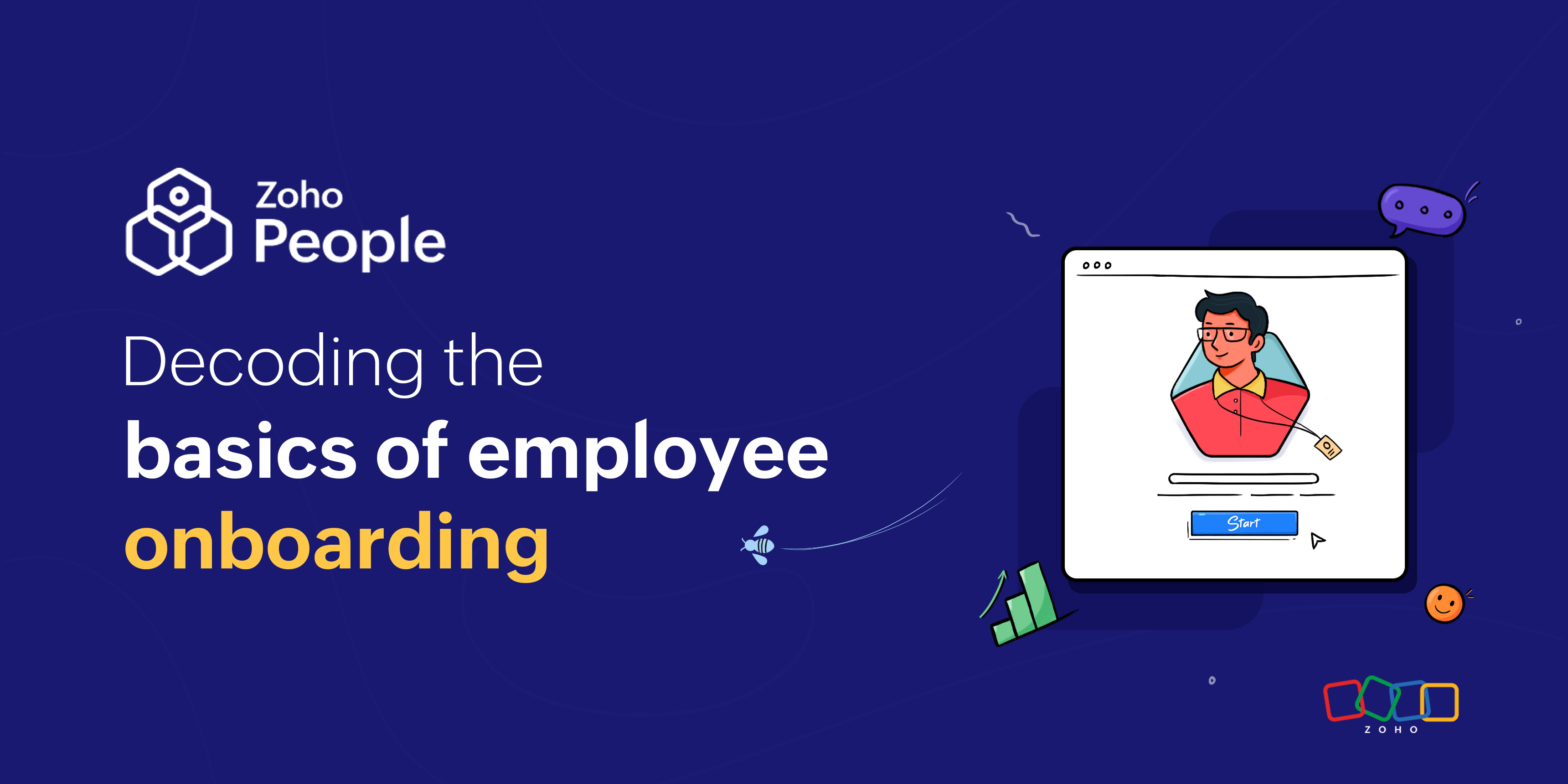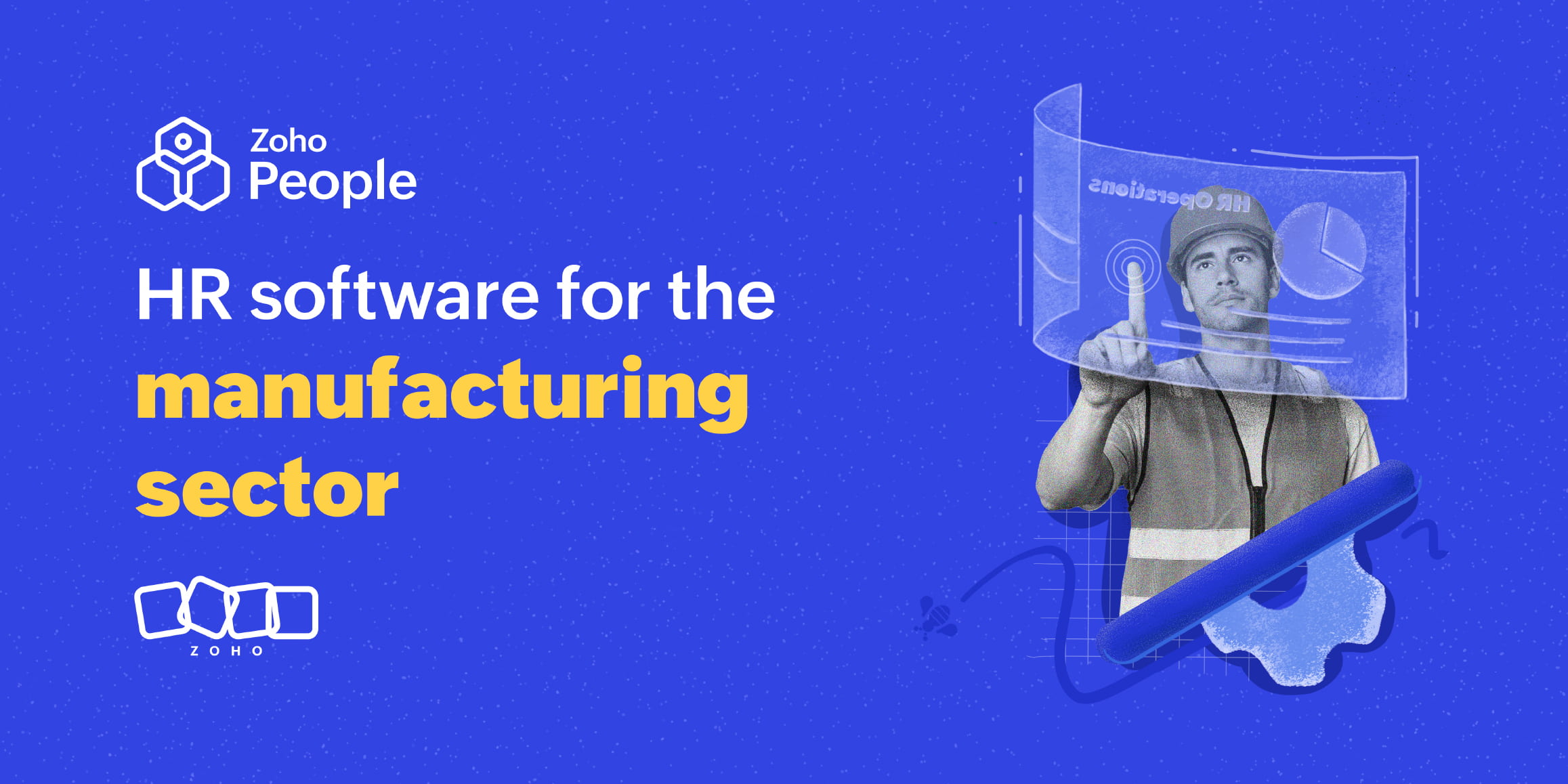- HOME
- More
- On Zoho People
- Decoding the basics of employee onboarding
Decoding the basics of employee onboarding
- Last Updated : October 19, 2023
- 938 Views
- 8 Min Read

As organizations strive to offer an exceptional working experience to their employees, it's become essential to establish a comprehensive onboarding program that sets new hires up for success. If you are looking to institute an onboarding program to help your new hires familiarize themselves with your organization, we've got you covered. Read on to get all your questions about onboarding answered.
What is employee onboarding?
Employee onboarding is a clearly defined process for welcoming new hires into your organization and helping them adapt to its culture. Onboarding includes everything from helping them complete all the necessary paperwork to helping them understand different policies, learn about the goals and responsibilities of their role, undergo training, use the tools and resources their role demands, and more. With a well-established onboarding program, organizations strive to build a culture that helps new hires adapt to their roles efficiently and confidently.
Why is onboarding important?
Supporting employees from the very beginning through a well-designed onboarding program can bring a multitude of benefits to your organization. Here's why every HR team should prioritize onboarding:
Keeps employees engaged
New hires are often uncertain about what lies ahead at their new workplace. A systematic onboarding program can be reassuring, since it provides them with a sense of what to expect. A positive onboarding experience goes a long way towards keeping employees engaged throughout their lifecycle with the organization.
2. Reduces new hire turnover
Many new hires quit their jobs between 45 days and six months in. Sometimes, they even leave during their onboarding phase. This is often due to the feeling of being neglected, unsupported, lonely, and underappreciated during their onboarding. Lack of proper candidate experience is also a major contributing factor. A good onboarding program provides your new hires with the support they need to become long-term team members.
Also read: Tips to boost new hire retention at your organization
3. Improves productivity
As part of onboarding, team managers and HR managers typically have a brief discussion with new hires to clarify their goals, objectives, and responsibilities. These conversations help them to organize meaningful and relevant training programs that align well with their new hire's goals. This goes a long way toward keeping your new hires productive from day one.
4. Builds better connections
A good onboarding program helps new hires build better connections with almost everyone in their organization. They'll have a good rapport with their HR team members, and develop a functional relationship with their managers, who will clarify goals, offer feedback, and provide recognition throughout the onboarding phase.
What are the steps involved in onboarding?
Every successful onboarding program will have four major steps to prepare new hires for success. Here are the four steps that will keep your employee engaged, motivated, and productive throughout their lifecycle:
Step 1: Candidate onboarding
Once your hiring process is done, it's essential to keep in touch with your new hires until they join your organization. During this phase of onboarding, you can offer your candidates more details about your organization and prompt them to complete all the necessary paperwork.
Step 2: Welcoming new hires
The second step in onboarding is all about creating a welcoming and comfortable work environment for your new hires on their very first day. Be sure to have their desk set up with all the necessary gadgets and tech tools. Have them meet their managers and their team members. Also, be sure to explain more about your organization, the kind of work you do, and how it benefits your customer community. This reassures new hires that they have a future at your organization. Elaborate on your company's everyday processes and policies. And touch base with them often to ensure that they are feeling connected to their new role.
Step 3: Training
The third step in onboarding involves offering training opportunities that are consistent with your employees' roles and responsibilities. Compliance can be covered during the training process too. It's helpful to design the training program to cater to different learning styles, including blended learning, self-paced learning, microlearning, and more. Assign training mentors to help new hires throughout their onboarding training journey.
Step 4: Transitioning to the new role
Once training is completed as part of onboarding, it's essential to help new hires transition slowly to their new role. Set up a meeting between managers and new hires to discuss goals, KRAs, and the expected results. Encourage managers to have a clear plan in place to assign meaningful work to new team members and increase their responsibilities gradually without overloading them. Remind them to follow up with new hires at regular intervals to offer guidance, feedback, and recognition.
Read more about the four phases of onboarding in our HR Knowledge Hive.
What are the best practices for onboarding?
Here are some best practices that'll help your onboarding program truly stand out:
1. Automate all the paperwork
Never-ending paperwork can suck all the joy out of the onboarding experience. That's why it's advisable to complete paperwork even before your new hires join your organization. Make use of intuitive onboarding software that lets you exchange documents and forms with your new hires online and get them e-signed seamlessly. This can make paperwork seem less daunting.
2. Make the first day their best day
Make your new hire's first day as special as possible. Send out your company swag in advance so that they can flaunt it from their very first day. If possible, arrange for a special lunch with their team members to help them collaborate and get to know their peers better. Offer an orientation that helps them feel like they are a part of your organization. Just be careful not to pack the entire day with nonstop activities.
3. Assign a new hire buddy
Sometimes, new hires hesitate to run to the HR team with every single question. Assigning a buddy to your newly onboarded employees may help them feel more comfortable getting answers. Select people who are friendly, approachable, supportive, and good at communication to be buddies. Provide a quick orientation to the buddies on the do's and don'ts, so they know what is expected of them.
4. Encourage job shadowing
Job shadowing, especially during the onboarding phase, can be helpful for acclimating new hires to their roles through hands-on experience. During this process, the new hires are encouraged to closely observe their peers. This will help them understand the in's and out's of everything involved in their roles and help them be prepared.
5. Keep communication open
Offer a space for your new hires to come to you in case they face any challenges or problems at their workplace. Make it a practice to touch base with your new hires once every two weeks, or once per month, to provide feedback and to check if they need any assistance or support.
How can you onboard employees remotely?
Since hybrid and remote workplace models are here to stay, remote onboarding has to be prioritized and streamlined. With the right set of tools and practices, your organization can ace remote onboarding while forging a strong connection to the remote hire. Here's how:
Have comprehensive onboarding software in place to help you automate the onboarding process. Through onboarding software, you'll be able to exchange documents, collect signatures, communicate with your new hires, and even provide training as part of onboarding.
Send all the essential gadgets, like laptops, smartphones, and tablets, well ahead of the employee's joining date. If possible, provide a small joining bonus that'll help them set up their home office. Send them personalized company swag too, if you offer it to on-premise employees.
Send videos, documents, PDFs, website URLs, and other materials that offer more information about your organization. Help your new hires understand your organization's journey, as well as its culture and values, target audience, and more
Organize a face-to-face meeting between your new hires and their team to help them familiarize themselves with colleagues and learn whom to contact for what.
Conduct frequent new hire surveys to gauge their satisfaction levels, and learn about their experience with onboarding, peer-to-peer collaboration, and their job responsibilities.
Remote onboarding resources
FAQs
1. Why is an onboarding checklist important?
A comprehensive new hire onboarding checklist is essential to ensure that you have everything that is required to onboard your new hires seamlessly before their first day. Maintaining an onboarding checklist will help you and your team stay organized and ensure that nothing is missed.
2. What is the purpose of onboarding?
A successful onboarding program will help new hires become a part of your organization seamlessly and provide them with the tech tools, resources, knowledge, training, and support they require. Ideally, it helps them become productive team members within a few days of joining your organization.
3. What is the role of HR in onboarding?
HR professionals often oversee the entire onboarding process. They welcome the new hires on their very first day, help them complete the necessary paperwork, provide the necessary resources, draft policies and procedures that help new hires adapt to your organization, introduce new hires to their managers and teams, organize training programs, run new hire surveys, and execute other onboarding processes.
4. What is required for onboarding?
For a successful onboarding program, you'll need onboarding documents, such as offer letters, I-9 forms, W-4 forms, necessary resources and office equipment, new-hire swag packages, policies about your organization, onboarding training programs, and new hire surveys.
5. What are the most common mistakes that occur during the onboarding phase?
Some common mistakes that occur during the onboarding phase include:
Lack of proper communication
Assigning never-ending, tedious paperwork to new hires on their first day
Not providing enough information about the organization and its work during the onboarding phase
Not offering enough training opportunities to new hires
Not receiving feedback from new hires to improve the onboarding process
6. How long should onboarding last?
An ideal onboarding program lasts for up to three months from the new hire's first day of joining. During this period, they are welcomed to your organization, prepared to adapt to your organization and their new role, trained, and helped to transition into their new role.
Building a successful onboarding program
Having a comprehensive onboarding program can go a long way towards helping new hires adapt to your organization while preparing them to work with their teammates and take on their job responsibilities. We hope this blog post answered all your questions regarding employee onboarding.
Zoho People, our HR software solution, comes with onboarding software that helps your organization seamlessly communicate with candidates, create onboarding checklists, onboard new hires, offer onboarding training, and a lot more. Learn more about Zoho People's onboarding software.
 Tarika
TarikaContent Specialist at Zoho People


